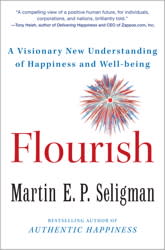Be Happy, Get Sick Less

This may seem like a no brainer, but when you have a bad day, remember: Pessimism can influence your susceptibility to illness, including cancer and cardiovascular disease, says Martin E.P. Seligman, author of Flourish: A Visionary New Understanding of Happiness and Well-Being.
1. Optimists take action and have healthier lifestyles.Optimists believe that their actions matter, whereas pessimists believe they are helpless and nothing they do will matter. Optimists try, while pessimists lapse into passive helplessness. Optimists therefore act on medical advice readily, as George Vaillant found when the surgeon general's report on smoking and health came out in 1964; it was the optimists who gave up smoking, not the pessimists. Optimists may take better care of themselves.
Even more generally, people with high life satisfaction (which correlates highly with optimism) are much more likely to diet, not to smoke, and to exercise regularly than people with lower life satisfaction. According to one study, happy people also sleep better than unhappy people.
Optimists not only follow medical advice readily, they also take action to avoid bad events, whereas pessimists are passive: optimists are more likely to seek safety in tornado shelters when there is a tornado warning than pessimists, who may believe the tornado is God's will. The more bad events that befall you, the more illness.
2. Social support. The more friends and the more love in your life, the less illness. George Vaillant found that people who have one person whom they would be comfortable calling at three in the morning to tell their troubles were healthier. John Cacioppo found that lonely people are markedly less healthy than sociable people. In an experiment, participants read a script over the phone to strangers -- reading in either a depressed voice or a cheerful voice. The strangers hang up on the pessimist sooner than on the optimist. Happy people have richer social networks than unhappy people, and social connectedness contributes to a lack of disability as we age. Misery may love company, but company does not love misery, and the ensuing loneliness of pessimists may be a path to illness.
3. Biological mechanisms. There are a variety of plausible biological paths. One is the immune system. Judy Rodin (whom I mentioned in the opening of the book), Leslie Kamen, Charles Dwyer, and I collaborated together in 1991 and took blood from elderly optimists and pessimists and tested the immune response. The blood of optimists had a feistier response to threat -- more infection- fighting white blood cells called T lymphocytes produced -- than the pessimists. We ruled out depression and health as confounds.
Another possibility is common genetics: optimistic and happy people might have genes that ward off cardiovascular disease or cancer.
Another potential biological path is a pathological circulatory response to repeated stress. Pessimists give up and suffer more stress, whereas optimists cope better with stress. Repeated episodes of stress, particularly when one is helpless, likely mobilize the stress hormone cortisol and other circulatory responses that induce or exacerbate damage to the walls of blood vessels and promote atherosclerosis. Sheldon Cohen, you will recall, found that sad people secrete more of the inflammatory substance interleukin-6, and that this results in more colds. Repeated episodes of stress and helplessness might set off a cascade of processes involving higher cortisol and lower levels of the neurotransmitters known as catecholamines, leading to long-lasting inflammation. Greater inflammation is implicated in atherosclerosis, and women who score low in feelings of mastery and high in depression have been shown to have worse calcification of the major artery, the trunk-like aorta. Helpless rats, in the triadic design, develop atherosclerosis at a faster rate than rats that demonstrate mastery.
Excessive production by the liver of fibrinogen, a substance used in clotting the blood, is another possible mechanism. More fibrinogen leads to more blood clots in the circulatory system by making the blood sludgy. People with high positive emotion show less of a fibrinogen response to stress than those with low positive emotion.
Heart rate variability (HRV), surprisingly, is another candidate for protection against cardiovascular disease. HRV is the short-term variation in beat-to-beat intervals, which is partly controlled by the parasympathetic (vagal) system of the central nervous system. This is the system that produces relaxation and relief. Accumulating evidence suggests that people with high heart rate variability are healthier, have less CVD, less depression, and better cognitive abilities.
Related Links:


